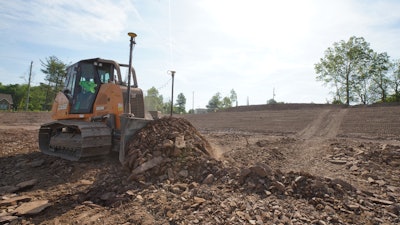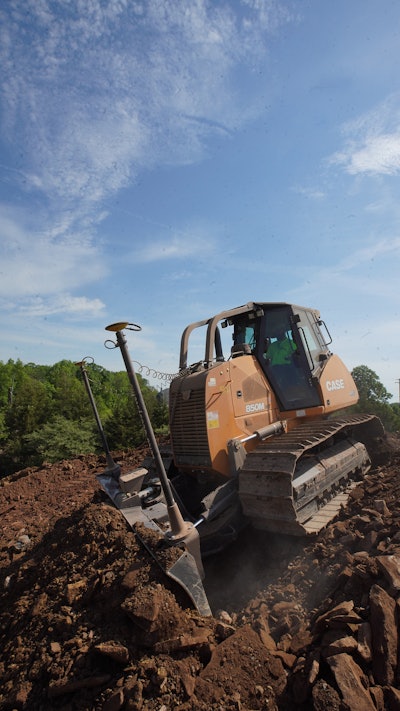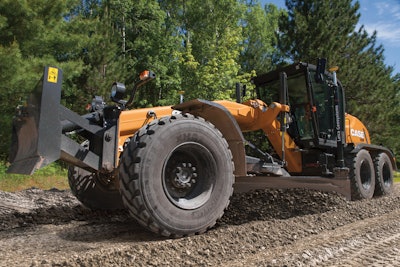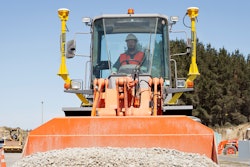
By now everyone is familiar with machine control technologies utilized on earthmoving applications. But as the costs continue to drop and the technology continues to advance, make sure you are not one of the contractors who gets left behind.
“There are very few earthmoving applications that won’t benefit from machine control in one way, shape or form,” explains Jeremy Dulak, product manager, Case Construction Equipment. “As acceptance and adoption is increasing, the contractors you are bidding against on a regular basis may already be using it to streamline their operations and make their bids more aggressive.”
Before adopting any technology, you need to develop an understanding of what it can do for your operation. In the case of grade control, there are many competing technologies, ranging from indicate only systems to full automation. There are important differences between guidance and automation. “Many of these solutions are guidance or indicate only solutions,” says Richie Snyder, marketing manager, CE Digital and Precision Solutions & Telematics at CNH Industrial. “This means that it is providing the operator with feedback on the screen that helps guide his or her actions. The solution still relies entirely on the input of the operator. It is simply letting them know where they are as it relates to their desired result and helps them dial in their work from there.” If you are going to add more complex work in the future, you may want to look at systems that can be easily adapted to 3D.Case Construction Equipment
If you are going to add more complex work in the future, you may want to look at systems that can be easily adapted to 3D.Case Construction Equipment
Many of the recent advancements are being made in automation. “The automatic solutions are where true machine control takes place,” explains Snyder. “This is where the system actually takes over the hydraulics of the machine and the blade to automate that performance. This is particularly helpful when working in a 3D world and trying to build complex grades and site profiles.” Automation helps level the playing field by elevating the performance of less experienced operators while also improving the performance of your best operators.
A Building Block Approach Makes Tech Accessible
Many systems will allow you to invest in lower cost 2D and use the components as building blocks as you move up to 3D. “It’s important to note that many of the components are the same for 2D; the foundational building blocks are already there,” says Snyder. “When you are ready, you can easily transition to 3D. 2D grading is machine control at its simplest form. Its tools work in two dimensions – plane and slope.” This is accomplished through basic technologies like lasers and sonic tracers.
The capabilities expand as you progress into more advanced systems. “3D is where things get really fun and it allows you to expand beyond working with just a slope or a plane,” says Snyder. “These machines can be indicate only, but reach the full potential of machine control when they are automatic. You do need to add some additional geospatial technologies to make it work, such as a GPS or a GNSS receiver or a universal total station. These systems still allow you to do plane and slope work, but really simplify those more complex curves and site plans."
You need to choose the correct technology for your worksite. “2D is great for those jobs that are consistent in nature and are often very simple,” says Nathanial Waldschmidt, product manager, Case Construction Equipment. “If you’re typically working on a single slope away from a fixed point of reference, which is often to ensure proper drainage, then a 2D system is going to be more than adequate. If you are doing driveways or parking lots or simple final grading in residential neighborhoods where all you are doing is making sure the grade is pitching away from the home or building, 2D will work. If you are only creating building pads and doing flat work, 2D will definitely work for you and help you ensure that you have that flat, clean plane that you are looking for.”
If you are going to add more complex work in the future, you may want to look at systems that can be easily adapted to 3D. “As your business grows, you evolve and the solution can grow with you to add on to that the next step,” says Waldschmidt. You can step up the capability of the machine control solution as you grow your business. “3D is for more complex projects.” This includes large infrastructure projects where there are countless points of reference throughout the site that must be hit. It makes contouring and more complex designs considerably easier.
Some 3D systems can perform in both 2D and 3D modes. This is important when you want to shift between simple plane surfaces and more complex 3D designs. “It is important to note that not all manufacturers can offer that solution of scaling back down and operating in a 2D situation,” notes Waldschmidt.
Case provided one example of a Leica Geosystems solution matched with a Case machine that can easily go between 2D and 3D. “A machine that is running 3D, that 3D panel also allows you to turn it into 2D mode,” says Snyder. “You absolutely can switch to 2D, eve though it is a 3D system.” For example, you can replace the GPS antenna that’s on top of a mast with a laser receiver. “Now we are operating that 3D machine in a 2D environment.”
Another consideration for machine control technology is the ability to increase jobsite safety. “Any machine control solution that we have running a 3D panel with the current software, we actually have the ability to put a sensor on a safety vest or on a vehicle, so the operator is aware of someone coming in close proximity,” says Snyder.
Understand your options
You basically have a few choices for acquiring machine control technology depending on if you already own the grading machine or if you are purchasing a new unit. “With machine control you really have three options when you are adding it to your fleet,” explains Snyder. “You can do it aftermarket. You can do it at the time of purchase with an aftermarket solution or you can do it at the time of purchase with a factory fit solution. Aftermarket is pretty self-explanatory. You own a machine, or you bought a machine and then you decide after purchase that you want to add machine control to that machine.” You will want to work with your dealer to determine the best solution. There will be some downtime for that machine to be equipped and calibrated with the technology. “You will need to work that into your schedule.” Your choice for acquiring machine control technology depends on if you already own the grading equipment or if you are purchasing a new unit. Options include aftermarket, aftermarket at time of purchase or factory fit.Case Construction Equipment
Your choice for acquiring machine control technology depends on if you already own the grading equipment or if you are purchasing a new unit. Options include aftermarket, aftermarket at time of purchase or factory fit.Case Construction Equipment
If you know ahead of time that you want machine control outfitted on your dozer or motor grader you can consult with the dealer during the machine purchase. “The advantage here is that at the time of purchase, you’re analyzing the combination of that machine and solution and working with an expert to ensure they are all well suited to work together,” says Snyder. “We focus a lot on scalability. If you start out with a 2D system as an initial investment, you’ll have the building blocks to expand into more advanced systems as your business grows.”
Some OEMs offer pre-installed solutions that remove the hassle of installing an aftermarket solution. “We recently introduced factory fit machine control on our dozers,” says Dulak. “The factory fit provides a few strong advantages. The first is simplified ordering. You can group the system to best fit your needs with the purchase of the machine. This combines all elements in the investment into a single payment, a single financing package and a single interest rate. It also reduces paperwork and administrative time, making it all very seamless.”
He adds, “The factory fit solution also ensures that when the machine arrives at the dealer, it’s just about ready to go. The machine and system are purpose built together ready to work. Ordering or buying the dozer with a factory fit machine control will also increase the residual value of the machine.
Rental can provide a way to test machine control before making the decision to purchase. “We’re seeing more dealer and independent rental operations making machine control available to their customers,” says Dulak. “Your local rental house may be a great way to dip your toes into machine control for a project or two without making a big first investment.”
Don’t Overcomplicate the Solution
Not every machine in your fleet requires a separate machine control solution. “Machine control is very versatile,” notes Dulak. “You can have multiple machines, but you don’t have to have the finishing kits on every single machine.” If machines are wired and the mounting points are installed, the technology can be transferred between machines. “You can transfer the hardware from one to the next. When one job is done you can take those pieces of hardware and put it on another dozer. It is a very flexible system tailored to your needs.” You can even use the technology on rental machines that are pre-wired for the technology.
Benefits can be immediately realized. “Machine control will give you much better control over your job costs,” reports Snyder. It’s going to make your work schedules much more predictable and it’s really going to help you out when you’re being competitive on your next bid.”
There is also less wear and tear on your equipment. “If you can complete a job in half the passes, you can complete a job with half the wear and tear on the equipment,” says Dulak. “The amount of work doesn’t change. That is constant. You know what you have to do to complete the job. Machine control let’s you do it with significantly less time on the equipment which has huge lifetime implications.”
This also allows better equipment utilization. “We had a contractor in the Carolinas who was able to go from two dozers on each site to one because the company was able to complete both the cut and the final grade with the same machine,” recalls Dulak. “The second dozer was able to be off on the next job working instead of sitting idle, which allows contractors to be smarter about how equipment is deployed.”
There are definite labor benefits that need to be considered. “First off, you typically have a person that’s checking grade for you,” says Synder. You can typically have that person off doing some other work that’s more productive. Depending upon the size of the site, many contractors will set aside a whole portion of their budget to account for re-staking. Stakes either get moved, they get run over, designs change and so on. This can get very costly. With machine control the data points don’t change and the design remains consistent within the system, unless you do a design change, at which point a new design is simply uploaded rather than re-staking the whole site.”
Leica Geosystems has built out an ROI calculator that lets you input real jobsite metrics and statistics to help you calculate realistic payback on a machine control system. It’s worth noting that this isn’t a guarantee on ROI, but it definitely helps paint the picture of what is actually possible.




















